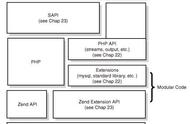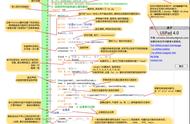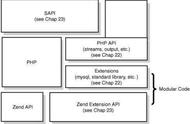本文分6个主题进行讲解
- PHP运行机制和原理
- PHP底层变量数据结构
- PHP传值赋值中的COW特性
- PHP垃圾回收机制
- PHP中数组底层分析
- PHP数组函数分类
PHP运行机制和原理
扫描 -> 解析 -> 编译 -> 执行 -> 输出
执行步骤
- 扫描
对代码进行词法和语法分析,将内容切割成一个个片段 (token)
- 解析
将代码片段筛掉空格注释等,将剩下的token 转成有意义的表达式
- 编译
将表达式编译成中间码 (opcode)
- 执行
将中间码一条条执行
- 输出
将执行结果输出到缓冲区
代码切割
$code = <<<EOF <?php echo 'hello world'l; $data = 1 1; echo $data; EOF; print_r(token_get_all($code));
执行结果
Array ( [0] => Array ( [0] => 376 [1] => <?php [2] => 1 ) [1] => Array ( [0] => 319 [1] => echo [2] => 2 ) [2] => Array ( [0] => 379 [1] => [2] => 2 ) [3] => Array ( [0] => 318 [1] => 'hello world' [2] => 2 ) [4] => Array ( [0] => 310 [1] => l [2] => 2 ) [5] => ; [6] => Array ( [0] => 379 [1] => [2] => 2 ) [7] => = [8] => Array ( [0] => 379 [1] => [2] => 3 ) [9] => Array ( [0] => 308 [1] => 1 [2] => 3 ) [10] => [11] => Array ( [0] => 308 [1] => 1 [2] => 3 ) [12] => ; [13] => Array ( [0] => 379 [1] => [2] => 3 ) [14] => Array ( [0] => 319 [1] => echo [2] => 4 ) [15] => Array ( [0] => 379 [1] => [2] => 4 ) [16] => ; )
观察上面可以得到三个信息
- Token id 例如空格回车都是 379
- token 字符串
- 行号
Token id 是Zend内部token对应码, 定义于zend_language_parser.h
提高PHP执行效率
- 压缩代码,去除无用注释和空白字符 (jquery.min.js)
- 尽量使用PHP内置函数或扩展函数
- 用 apc/xcache/opcache 等缓存PHP的opcode
- 缓存复杂和耗时的运算结果
- 能异步处理的不要同步处理,如发送邮件
- HHVM 为何速度快
通过虚拟机(类似java) 直接将PHP转换成二进制字节码运行,执行时不用每次都去解析。
PHP底层变量数据结构使用 zval 结构体保存,下面代码在 Zend/zend.h 定义
typedef union _zvalue_value { /* 下面定义描述了PHP的8大数据类型 */ long lval; // 长整型 布尔型 double dval; // 浮点型 struct { // 字符串型 char *val; int len; // strlen 返回这个值 } str; // NULL 类型表示本身为空 hashTable *ht; // 数组使用哈希表实现 zend_object_value obj; // 对象类型 } zvalue_value; struct _zval_struct { zvalue_value value; /* 变量的值 */ zend_uint refcount__gc; zend_uchar type; /* 变量的类型 */ zend_uchar is_ref__gc }; typedef struct _zval_struct zval;
变量类型的定义,下面代码在 Zend/zend_types.h 定义
typedef unsigned int zend_uint; typedef unsigned char zend_uchar;
PHP数据8大类型统一通过 zvalue_value 联合体存储
联合体自身为空 描述 null long 描述 int bool double 描述 float str 描述 string HashTable 描述 数字数组和关联数组 zend_object_value 描述 对象和资源
PHP变量类型描述使用 zend_uchar type 描述
#define IS_NULL 0 #define IS_LONG 1 #define IS_DOUBLE 2 #define IS_BOOL 3 #define IS_ARRAY 4 #define IS_OBJECT 5 #define IS_STRING 6 #define IS_RESOURCE 7 #define IS_CONSTANT 8 #define IS_CONSTANT_ARRAY 9
例如 $a=3 结构体如下(伪代码)
struct { zvalue_value = 3; refcount__gc = 1; type = IS_LONG; is_ref__gc = 0; }
$a 就像指针一样指向上面的结构体
PHP传值赋值中的COW特性在 _zval_struct 数据结构中还有下面两个成员
- zend_uint refcount__gc 表示被引用多少次,每次引用 1
- zend_uchar is_ref__gc 表示普通变量还是引用变量
下面通过编写代码了解引用机制
此处我使用的是 php5.4,需要安装 xdebug 来查看变量引用
注意使用 php7.2 测试的时候引用数会一直为0
安装 xdebug
编译生成 xdebug.so
yum -y install php-devel tar xf xdebug-2.8.0alpha1.tgz cd xdebug-2.8.0alpha1 phpize find /usr/ -name "php-config" ./configure --with-php-config=/usr/bin/php-config make && make install ls /usr/lib64/php/modules/
配置 xdebug
php --ini echo 'zend_extension=/usr/lib64/php/modules/xdebug.so' >> /etc/php.ini systemctl restart php72-php-fpm.service php -m | grep xdebug
编写测试代码
$a = 3; xdebug_debug_zval('a');
输出
a: (refcount=1, is_ref=0)=3
- refcount 引用数为1
- is_ref 为0表示普通变量
- =3 表示值为3
开始引用
$a = 3; $b = $a; xdebug_debug_zval('a'); xdebug_debug_zval('b');
输出
a: (refcount=2, is_ref=0)=3
b: (refcount=2, is_ref=0)=3
赋予新值
$a = 3; $b = $a; $b = 5; xdebug_debug_zval('a'); xdebug_debug_zval('b');
输出
a: (refcount=1, is_ref=0)=3
b: (refcount=1, is_ref=0)=5
传递地址
$a = 3; $b = &$a; xdebug_debug_zval('a'); xdebug_debug_zval('b');
输出
a: (refcount=2, is_ref=1)=3
b: (refcount=2, is_ref=1)=3
is_ref 该变量从普通变量转成引用变量
赋予新值
$a = 3; $b = &$a; $c = $a; $b = 5; xdebug_debug_zval('a'); xdebug_debug_zval('b'); xdebug_debug_zval('c');
a: (refcount=2, is_ref=1)=5
b: (refcount=2, is_ref=1)=5
c: (refcount=1, is_ref=0)=3
总结
- 变量之间传值是通过引用赋值形式,无需开辟新的空间,节省资源
- 当一个变量的值发生改变时,会复制一份来存新的值,取消引用,称为 copy on write (COW)
- 引用变量不会触发COW
什么是垃圾
上海人: 你算什么垃圾?
如果一个zval 没有任何变量引用它,那它就是垃圾
?: (refcount=0, is_ref=0)=5
为啥要清理垃圾?
有人说php线程结束时会销毁所有变量,关闭所有句柄资源,不是自动的嘛,为啥要清理
- 如果php 短时间内处理多个大文件时(如1G的电影),处理完不回收继续处理下一个,会造成内存溢出
- 如果php 是个守护进程或者长时间运行的脚本,不回收垃圾,慢慢积累会造成内存溢出
如何清理垃圾
- 找垃圾
- 清除
- 找垃圾
通过 get_defined_vars 查看所有已定义变量
底层代码 zend_globals.h 定义了存储所有变量的两个哈希表
struct _zend_executor_globals { ... HashTable *active_symbol_table; //局部变量符号表 HashTable symbol_table; //全局变量符号表 ... }
找到所有已定义的变量后,寻找哪些变量引用数为0
struct _zval_struct{ ... zend_uint refcount__gc; zend_uchar is_ref__gc; ... }
- 清理垃圾
如上面将 refcount__gc 为0的变量清除,这个思路是 PHP5.2版本之前的做法了
PHP5.3后用 引用计数系统中同步周期回收 算法来清除
其实新算法也是基于 refcount__gc 来回收,那么为什么要用新算法呢?
我们知道 refcount__gc 为0的一定是垃圾
但是并不是所有的垃圾 refcount__gc 都为0
也有 refcount__gc 不为0 的垃圾,如下实验可以产生不为0的垃圾
一个例子
$a = ['a']; $a[] = &$a; //引用自己 xdebug_debug_zval('a');
输出
a: (refcount=2, is_ref=1)=array (
0 => (refcount=1, is_ref=0)='a',
1 => (refcount=2, is_ref=1)=...
)
第二元素: ... 代表递归,引用数2,是一个指针引用变量
官方提供的一张图

此时删掉 $a
$a = ['a']; $a[] = &$a; unset($a); xdebug_debug_zval('a');
输出
a: no such symbol
因为 $a 被删了,所以xdebug打印不出来,那么此时理论结构如下
(refcount=1, is_ref=1)=array (
0 => (refcount=1, is_ref=0)='a',
1 => (refcount=1, is_ref=1)=...
)

此时这个 zval 已经没有符号 (symbol) 引用了,但是它因为自己引用自己 refcount 为1,所以它是一个奇葩的垃圾
对于此情况php脚本结束时,会自动清理,当结束前会占用空间
因此 5.2 版本之前的垃圾清理思路不能覆盖这种情况
引用计数系统中同步周期回收算法 (Concurrent Cycle Collection in Reference Counted System)
继续以上面代码为例进行说明
新算法说明:
将 $a 作为疑似垃圾变量,进行模拟删除 (refcount--),然后模拟恢复,恢复条件是有其他变量引用该值时才进行模拟恢复 (refcount )
这样没能恢复成功的就是垃圾了,把它删除即可。
例如上面的奇葩垃圾:
(refcount=1, is_ref=1)=array (
0 => (refcount=1, is_ref=0)='a',
1 => (refcount=1, is_ref=1)=...
)
模拟删除后变成:
(refcount=0, is_ref=1)=array (
0 => (refcount=0, is_ref=0)='a',
1 => (refcount=0, is_ref=1)=...
)
然后模拟恢复:
因为没有类似 $a 这种 symbol 取指向该zval,所以恢复不来
何时清除
通过上面的算法疑似垃圾会存放到一个区域(垃圾站),只有垃圾站满了才会立刻清除。 注意前提是开启垃圾回收
开启垃圾回收两种方式
- php.ini 下的 zend.enable_gc = On 默认开启
- 通过 gc_enable() 和 gc_disable() 来打开或关闭垃圾回收
可以直接使用 gc_collect_cycles() 函数强制执行周期回收
最后说了那么多,其实只需要了解其中的原理,整个过程不需要PHP开发人员参与,只需要调用 gc_enable() 或 gc_collect_cycles() 即可实现自动回收
PHP中数组底层分析先复习一下数组特性
PHP 数组键的特性
$arr = [ 1 => 'a', '1' => 'b', 1.5 => 'c', true => 'd', ]; print_r($arr);
Array
(
[1] => d
)
key 可以是 integer 或 string
value 可以是任意类型
key 有如下特性
- 数字字符串会被转成整型 '1' => 1
- 浮点型和布尔型转成整型 1.3 =》 1
- null会被当做空字符串 null => ''
- 键名不可以使用对象和数组
- 相同键名后面覆盖前面
访问数组元素
- $arr[key]
- $arr{key}
5.4 版本后可以使用如下
function getArr(){ return [1,2,3,4]; } echo getArr()[2];
删除数组元素
$a = [1,2,3,4]; foreach ($a as $k => $v) { unset($a[$k]); } $a[] = 5; print_r($a);
Array
(
[4] => 5
)
- 删除不会重置索引
数组遍历
- for
- foreach
- array_walk
- array_map
- current 和 next
数组内部实现
实现使用两个结构 HashTable 和 bucket

- 什么是 HashTable
哈希表,通过关键字直接访问内存存储位置的数据结构。
通过把关键字进行哈希函数计算,得到映射到表中的位置使得: 查找,插入,修改,删除均在O(1)完成

下面代码在 Zend/zend_types.h
typedef struct _zend_array HashTable; struct _zend_array { zend_refcounted_h gc; union { struct { ZEND_ENDIAN_LOHI_4( zend_uchar flags, zend_uchar nApplyCount, zend_uchar nIteratorsCount, zend_uchar consistency) } v; uint32_t flags; } u; uint32_t nTableMask; Bucket *arData; uint32_t nNumUsed; uint32_t nNumOfElements; uint32_t nTableSize; uint32_t nInternalPointer; zend_long nNextFreeElement; dtor_func_t pDestructor; };
旧版结构体
typedef struct _hashtable { uint nTableSize; uint nTableMask; uint nNumOfElements; ulong nNextFreeElement; Bucket *pInternalPointer; Bucket *pListHead; Bucket *pListTail; Bucket **arBuckets; unsigned char nApplyCount; };
成员说明nTableSizeBucket大小,最小为8,以2x增长nTableMask索引优化 nTableSize-1nNumOfElements元素个数 使用count()函数直接返回这个nNextFreeElement下一个索引位置 foreach使用pInternalPointer当前遍历的指针,foreach比for快的原因,reset current函数使用pListHead存储数组头部指针pListTail存储数组尾部指针arBuckets实际存储容器arDataBucket数据nApplyCount记录被递归次数,防止死循环递归
typedef struct bucket { ulong h; uint nKeyLength; void *pData; void *pDataPtr; struct bucket *pListNext; struct bucket *pListLast; struct bucket *pNext; struct bucket *pLast; const char *arKey; };
成员说明h对char *key进行hash后的值,或是用户指定数字索引值nKeyLength哈希关键字长度,若为索引数字则为0pData指向value 一般是用户数据的副本,若为指针数据则指向指针pDataPtr如果是指针数据,指针会指向真正value,上面指向此pListNext整个hash表下个元素pListLast整个hash表上个元素pNext同一个hash的下一个元素pLast同一个hash的上一个元素arKey保存当前key对应的字符串

foreach 遍历先从 HashTable 的 pListHead -> pListNext
pNext 和 pLast 用于hash冲突同一个hash不同个bucket之间指针
PHP数组函数分类建议体验一下下面的函数,不用记住,只是留个印象,当你需要用的时候会联想起来的,而不用自己去实现
遍历
- prev
- next
- current
- end
- reset
- each
排序
- sort
- rsort
- asort
- ksort
- krsort
- uasort
- uksort
查找
- in_array
- array_search
- array_key_exists
分合
- array_slice
- array_splice
- implode
- explode
- array_combine
- array_chunk
- array_keys
- array_values
- array_columns
集合
- array_merge
- array_diff
- array_diff_*
- array_intersect
- array_intersect_*
队列/栈
- array_push
- array_pop
- array_shift
其他
- array_fill
- array_flip
- array_sum
- array_reverse














